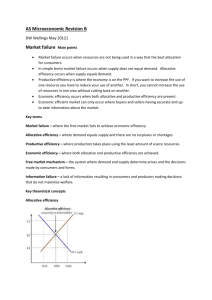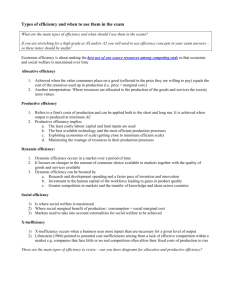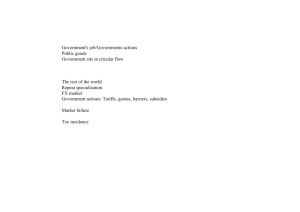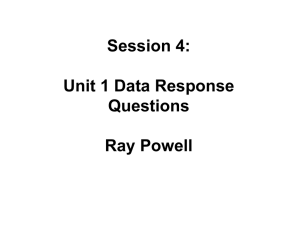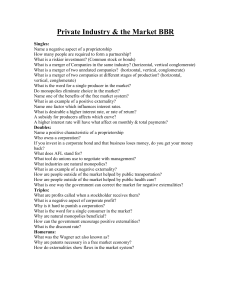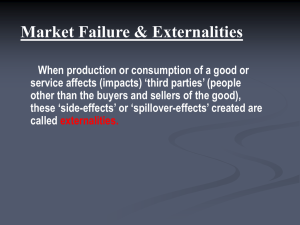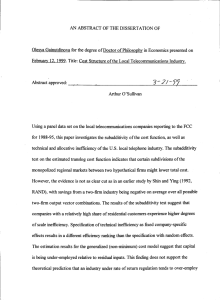Market Failure - Oxford Books Online
advertisement
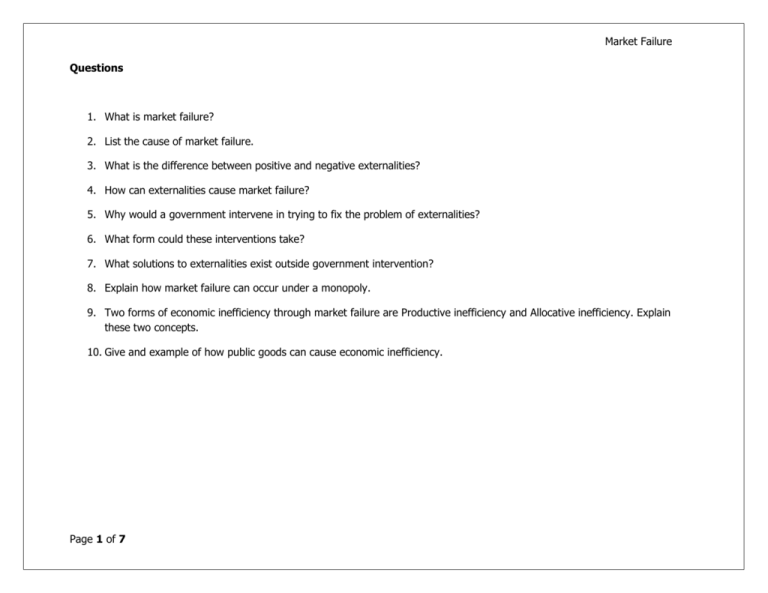
Market Failure Questions 1. What is market failure? 2. List the cause of market failure. 3. What is the difference between positive and negative externalities? 4. How can externalities cause market failure? 5. Why would a government intervene in trying to fix the problem of externalities? 6. What form could these interventions take? 7. What solutions to externalities exist outside government intervention? 8. Explain how market failure can occur under a monopoly. 9. Two forms of economic inefficiency through market failure are Productive inefficiency and Allocative inefficiency. Explain these two concepts. 10. Give and example of how public goods can cause economic inefficiency. Page 1 of 7 Market Failure Answers 1. Market failure exists when the competitive outcome of markets is not efficient from the point of view of the economy as a whole. 2. Causes of market failure: Externalities Imperfect information Pure public goods and quasi-public goods Market dominance and the abuse of monopoly Factor immobility Equity (fairness) issues 3. An externality is an impact on any party not involved in a given economic transaction. A positive externality is beneficial to the third party, while a negative externality is detrimental. 4. See box: Negative externalities create external costs. If the market does not take them into account the result is the socially efficient output is less than the current output. The diagram below shows In the absence of externalities, the private costs of the supplier are the same as the costs for society. But if there are negative externalities, we must add the external costs to the firm’s supply curve to find the social cost curve. Page 2 of 7 Market Failure Source: http://www.tutor2u.net/economics/revision-notes/as-marketfailure-negative-externalities.html Where positive externalities exist, the good or service may be under consumed or under provided since the free market may fail to value them correctly or take them into account when pricing the product. In the diagram above, the normal market equilibrium is at P1 and Q1 – but if there are external benefits, the Q1 is an output below the level that maximises social welfare. Page 3 of 7 Market Failure Source: http://www.tutor2u.net/economics/revision-notes/as-marketfailure-positive-externalities.html 5. If there is no incentive for either consumers or producers to solve the problems associated with externalities then it is the job of the government to intervene. Here are some of the options open to the government. Page 4 of 7 Market Failure 6. Government intervention on externalities: Taxation Subsidies Regulation Policies to increase competition and reduce immobility of factors of production Provision & finance of public and merit goods Introduction/expansion of ‘market-based incentives’ to change both consumer and producer behaviour. 7. Externalities solutions outside government intervention: Moral codes and social sanctions Voluntary organisations – charity groups, lobby groups Internalization - when activities with complementary externalities are merged into one firm, thus eliminating the externality Contracts - parties through negotiation can agree as to how to regulate the externality 8. See box: Monopoly prices will normally be above those in competitive markets. This will result in the loss of consumer surplus, The diagram below shows the loss to society as a result of monopoly in terms of consumer surplus and producer surplus. Under monopoly, the market fails in that it is not efficient using any measure. Page 5 of 7 Market Failure The perfectly competitive equilibrium occurs where supply equals demand (point C), price Ppc and quantity Qpc. As we saw in the first diagram, the monopolist raises the price (Pm) resulting in reduced quantity (Qm) so as to maximise his profits. Source: http://www.scool.co.uk/topic_quicklearn.asp?loc=ql&topic_id=1&quicklearn_id=4&subject_id=11&ebt=39&ebn=&ebs=&ebl=&elc=13 Page 6 of 7 Market Failure 9. See box: Allocative inefficiency - Allocative efficiency theory says that the distribution of resources between alternatives does not fit with consumer taste (perceptions of costs and benefits). For example, a company may have the lowest costs in "productive" terms, but the result may be inefficient in allocative terms because the "true" or social cost exceeds the price that consumers are willing to pay for an extra unit of the product. This is true, for example, if the firm produces pollution (see also external cost). Consumers would prefer that the firm and its competitors produce less of the product and charge a higher price, to internalize the external cost. Productive inefficiency - says that we could produce the given output at a lower cost -- or could produce more output for given cost. For example, a company that is inefficient will have higher operating costs and will be at a competitive disadvantage (or have lower profits than other firms in the market). Source: http://en.wikipedia.org/wiki/Inefficiency 10. A public good is something that provides a benefit to people, but because of its nature, we can’t exclude people from consuming it, whether they pay for it or not. The classic example is a lighthouse. All ships will benefit from using it and would be willing to pay for it, but once it is in place there is no way of excluding non-payers from using it. Rationally self-interested people would not continue to pay for something they can get without having to pay for it. Page 7 of 7


